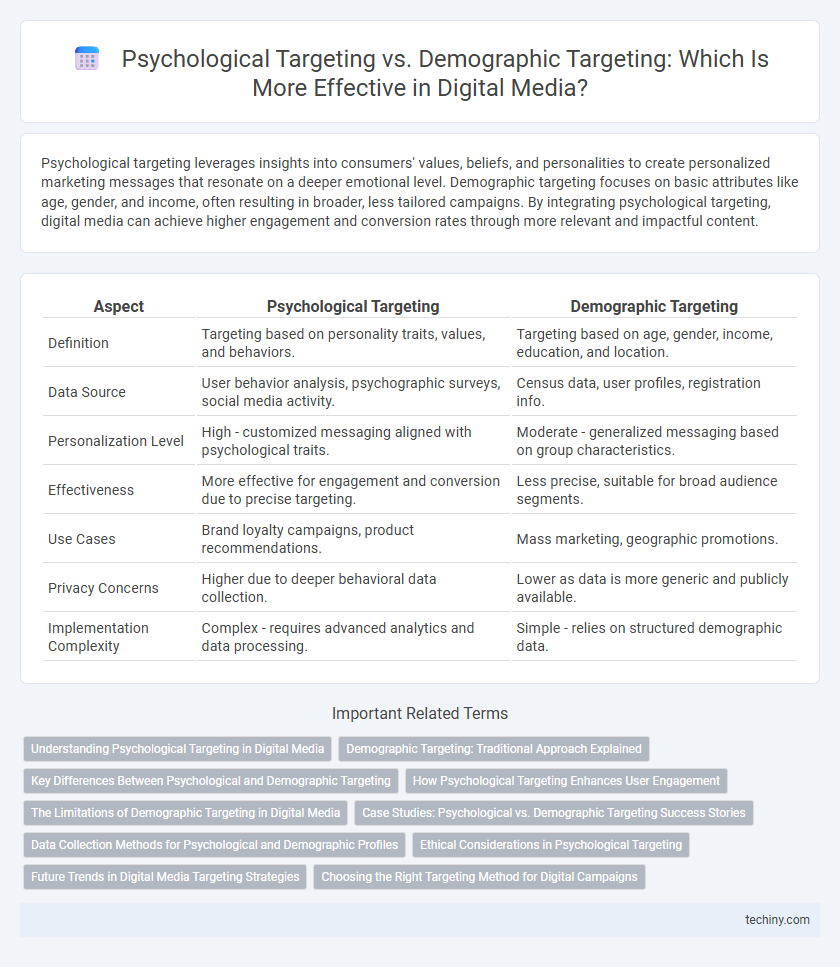Psychological targeting leverages insights into consumers' values, beliefs, and personalities to create personalized marketing messages that resonate on a deeper emotional level. Demographic targeting focuses on basic attributes like age, gender, and income, often resulting in broader, less tailored campaigns. By integrating psychological targeting, digital media can achieve higher engagement and conversion rates through more relevant and impactful content.
Table of Comparison
| Aspect | Psychological Targeting | Demographic Targeting |
|---|---|---|
| Definition | Targeting based on personality traits, values, and behaviors. | Targeting based on age, gender, income, education, and location. |
| Data Source | User behavior analysis, psychographic surveys, social media activity. | Census data, user profiles, registration info. |
| Personalization Level | High - customized messaging aligned with psychological traits. | Moderate - generalized messaging based on group characteristics. |
| Effectiveness | More effective for engagement and conversion due to precise targeting. | Less precise, suitable for broad audience segments. |
| Use Cases | Brand loyalty campaigns, product recommendations. | Mass marketing, geographic promotions. |
| Privacy Concerns | Higher due to deeper behavioral data collection. | Lower as data is more generic and publicly available. |
| Implementation Complexity | Complex - requires advanced analytics and data processing. | Simple - relies on structured demographic data. |
Understanding Psychological Targeting in Digital Media
Psychological targeting in digital media leverages behavioral data, personality traits, and emotional triggers to create personalized ad experiences that resonate more deeply with individual users. Unlike demographic targeting, which segments audiences by age, gender, or location, psychological targeting analyzes users' online behaviors, preferences, and motivations to predict decision-making patterns. This approach increases engagement and conversion rates by aligning messaging with users' intrinsic psychological needs and values.
Demographic Targeting: Traditional Approach Explained
Demographic targeting in digital media focuses on categorizing audiences based on age, gender, income, education, and location, enabling advertisers to tailor campaigns to specific population segments. This traditional approach relies on quantifiable data, offering straightforward metrics to optimize ad spend and measure campaign effectiveness. Although less personalized than psychological targeting, demographic targeting remains a foundational strategy for reaching broad consumer groups with relevant messaging.
Key Differences Between Psychological and Demographic Targeting
Psychological targeting leverages behavioral data, personality traits, and cognitive patterns to tailor digital media campaigns, enhancing engagement through emotional and motivational insights. Demographic targeting focuses on age, gender, income, and education level to segment audiences, relying on quantifiable, static attributes. The key difference lies in psychological targeting's dynamic, in-depth understanding of user mindset versus demographic targeting's reliance on broad, surface-level group characteristics.
How Psychological Targeting Enhances User Engagement
Psychological targeting in digital media leverages user personality traits, values, and emotional triggers to create highly personalized content that resonates on a deeper level, significantly boosting engagement rates. Unlike demographic targeting, which categorizes audiences by age, gender, or location, psychological targeting taps into intrinsic motivations and cognitive biases, leading to more meaningful interactions and higher conversion rates. This approach enables marketers to deliver relevant ads that foster trust and loyalty, ultimately driving sustained user engagement.
The Limitations of Demographic Targeting in Digital Media
Demographic targeting in digital media often overlooks the nuanced psychological and behavioral drivers influencing consumer decisions, limiting campaign effectiveness. This approach relies heavily on broad categories such as age, gender, and income, which fail to capture individual motivations and preferences. Consequently, marketers miss opportunities for personalized engagement and face lower conversion rates when compared to psychologically targeted strategies.
Case Studies: Psychological vs. Demographic Targeting Success Stories
Case studies reveal that psychological targeting significantly outperforms demographic targeting by leveraging individual personality traits, values, and motivations to craft personalized digital media campaigns. For example, a study by Cambridge Analytica demonstrated a 10-15% increase in engagement rates when ads were tailored to users' psychological profiles, compared to traditional demographic segments focused on age or gender. Brands employing psychological targeting report higher conversion rates and stronger customer loyalty, illustrating the effectiveness of deep behavioral insights over broad demographic assumptions.
Data Collection Methods for Psychological and Demographic Profiles
Psychological targeting relies on data collection methods such as behavioral analysis, online activity tracking, and psychometric assessments to build detailed personality and preference profiles. Demographic targeting primarily uses traditional data sources like census data, age, gender, income, and location gathered through surveys, registration forms, and third-party databases. Advanced AI algorithms enhance psychological data accuracy by interpreting complex patterns, while demographic data remains foundational for broad audience segmentation.
Ethical Considerations in Psychological Targeting
Psychological targeting in digital media involves using consumer behavior and emotional data to tailor advertisements, raising ethical concerns regarding privacy and manipulation. Unlike demographic targeting, which categorizes audiences by age, gender, or location, psychological targeting delves deeper into individual psyche, potentially exploiting vulnerabilities. Ensuring transparency, user consent, and data protection is essential to maintaining ethical standards in psychological targeting practices.
Future Trends in Digital Media Targeting Strategies
Psychological targeting leverages user behavior, interests, and personality traits to create highly personalized digital media campaigns, outperforming traditional demographic targeting that segments audiences by age, gender, or location. Advances in AI and machine learning enable more precise prediction of consumer motivations and emotional triggers, driving higher engagement and conversion rates. Future trends indicate a shift toward integrating psychographic data with real-time contextual signals to deliver dynamic, adaptive advertising experiences.
Choosing the Right Targeting Method for Digital Campaigns
Psychological targeting leverages user behaviors, interests, and personality traits to create highly personalized digital campaigns, resulting in improved engagement rates compared to traditional demographic targeting, which relies on age, gender, and location data. Choosing the right targeting method depends on campaign goals, with psychological targeting excelling in brand affinity and emotional connection, while demographic targeting provides broader reach and straightforward segmentation. Integrating both approaches often yields optimal results by combining precise audience insights with scalable targeting strategies.
Psychological Targeting vs Demographic Targeting Infographic

 techiny.com
techiny.com